3D-Printed Polyamide 12/Styrene–Acrylic Copolymer–Boron Nitride (PA12/SA–BN) Composite with Macro and Micro Double Anisotropic Thermally Conductive Structures
Abstract
:1. Introduction
2. Experimental Section
2.1. Materials
2.2. Specimen Preparation
2.3. Characterizations
3. Results and Discussion
3.1. Macro- and Micro-Structures of Different Composites
3.2. Thermal Conductivity and Enhancement
3.3. Simulations for Thermal Conduction
3.4. Infrared Thermal Images of Different Composites
4. Conclusions
Supplementary Materials
Author Contributions
Funding
Institutional Review Board Statement
Data Availability Statement
Acknowledgments
Conflicts of Interest
References
- Fu, C.; Li, Q.; Lu, J.; Mateti, S.; Cai, Q.; Zeng, X.; Du, G.; Sun, R.; Chen, Y.; Xu, J.; et al. Improving thermal conductivity of polymer composites by reducing interfacial thermal resistance between boron nitride nanotubes. Compos. Sci. Technol. 2018, 165, 322–330. [Google Scholar]
- Xu, X.; Chen, J.; Zhou, J.; Li, B. Thermal Conductivity of Polymers and Their Nanocomposites. Adv. Mater. 2018, 30, 1705544. [Google Scholar]
- Xue, Y.; Lofland, S.; Hu, X. Protein-based flexible thermal conductive materials with continuous network structure: Fabrication, properties, and theoretical modeling. Compos. Part B Eng. 2020, 201, 108377. [Google Scholar]
- An, D.; Cheng, S.; Zhang, Z.; Jiang, C.; Fang, H.; Li, J.; Liu, Y.; Wong, C.-P. A polymer-based thermal management material with enhanced thermal conductivity by introducing three-dimensional networks and covalent bond connections. Carbon 2019, 155, 258–267. [Google Scholar]
- Xu, H.; Li, X.; Li, P.; Ma, L.; Li, H.; Shi, L.; Wang, M.; Chen, H.; Song, G. Enhancing mechanical performances of polystyrene composites via constructing carbon nanotube/graphene oxide aerogel and hot pressing. Compos. Sci. Technol. 2020, 195, 108191. [Google Scholar]
- Wu, Z.; Xu, C.; Ma, C.; Liu, Z.; Cheng, H.M.; Ren, W. Synergistic Effect of Aligned Graphene Nanosheets in Graphene Foam for High-Performance Thermally Conductive Composites. Adv. Mater. 2019, 31, 1900199. [Google Scholar]
- Zhuang, Y.; Zheng, K.; Cao, X.; Fan, Q.; Ye, G.; Lu, J.; Zhang, J.; Ma, Y. Flexible Graphene Nanocomposites with Simultaneous Highly Anisotropic Thermal and Electrical Conductivities Prepared by Engineered Graphene with Flat Morphology. ACS Nano 2020, 14, 11733–11742. [Google Scholar]
- Fang, H.; Li, G.; Wang, K.; Wu, F. Significant Improvement of Thermal Conductivity of Polyamide 6/Boron Nitride Composites by Adding a Small Amount of Stearic Acid. Polymers 2023, 15, 1887. [Google Scholar]
- Jia, H.; Kong, Q.-Q.; Yang, X.; Xie, L.-J.; Sun, G.-H.; Liang, L.-L.; Chen, J.-P.; Liu, D.; Guo, Q.-G.; Chen, C.-M. Dual-functional graphene/carbon nanotubes thick film: Bidirectional thermal dissipation and electromagnetic shielding. Carbon 2021, 171, 329–340. [Google Scholar]
- Tong, J.; Zheng, H.; Fan, J.; Li, W.; Wang, Z.; Zhang, H.; Dai, Y.; Chen, H.; Zhu, Z. Fabricating Well-Dispersed Poly(Vinylidene Fluoride)/Expanded Graphite Composites with High Thermal Conductivity by Melt Mixing with Maleic Anhydride Directly. Polymers 2023, 15, 1747. [Google Scholar]
- Peng, L.; Xu, Z.; Liu, Z.; Guo, Y.; Li, P.; Gao, C. Ultrahigh Thermal Conductive yet Superflexible Graphene Films. Adv. Mater. 2017, 29, 1700589. [Google Scholar]
- Do, N.B.D.; Imenes, K.; Aasmundtveit, K.E.; Nguyen, H.-V.; Andreassen, E. Thermal Conductivity and Mechanical Properties of Polymer Composites with Hexagonal Boron Nitride—A Comparison of Three Processing Methods: Injection Moulding, Powder Bed Fusion and Casting. Polymers 2023, 15, 1552. [Google Scholar]
- Ji, C.; Wang, Y.; Ye, Z.; Tan, L.; Mao, D.; Zhao, W.; Zeng, X.; Yan, C.; Sun, R.; Kang, D.J.; et al. Ice-Templated MXene/Ag-Epoxy Nanocomposites as High-Performance Thermal Management Materials. ACS Appl. Mater. Interfaces 2020, 12, 24298–24307. [Google Scholar]
- Zeng, X.; Sun, J.; Yao, Y.; Sun, R.; Xu, J.B.; Wong, C.P. A Combination of Boron Nitride Nanotubes and Cellulose Nanofibers for the Preparation of a Nanocomposite with High Thermal Conductivity. ACS Nano 2017, 11, 5167–5178. [Google Scholar]
- Chen, J.; Huang, X.; Sun, B.; Wang, Y.; Zhu, Y.; Jiang, P. Vertically Aligned and Interconnected Boron Nitride Nanosheets for Advanced Flexible Nanocomposite Thermal Interface Materials. ACS Appl. Mater. Interfaces 2017, 9, 30909–30917. [Google Scholar]
- Zhang, X.; Zhang, J.; Xia, L.; Li, C.; Wang, J.; Xu, F.; Zhang, X.; Wu, H.; Guo, S. Simple and Consecutive Melt Extrusion Method to Fabricate Thermally Conductive Composites with Highly Oriented Boron Nitrides. ACS Appl. Mater. Interfaces 2017, 9, 22977–22984. [Google Scholar] [PubMed]
- Hu, M.; Feng, J.; Ng, K.M. Thermally conductive PP/AlN composites with a 3-D segregated structure. Compos. Sci. Technol. 2015, 110, 26–34. [Google Scholar]
- Chen, H.; Ginzburg, V.V.; Yang, J.; Yang, Y.; Liu, W.; Huang, Y.; Du, L.; Chen, B. Thermal conductivity of polymer-based composites: Fundamentals and applications. Prog. Polym. Sci. 2016, 59, 41–85. [Google Scholar]
- Burger, N.; Laachachi, A.; Ferriol, M.; Lutz, M.; Toniazzo, V.; Ruch, D. Review of thermal conductivity in composites: Mechanisms, parameters and theory. Prog. Polym. Sci. 2016, 61, 1–28. [Google Scholar]
- Chen, C.; Xue, Y.; Li, Z.; Wen, Y.; Li, X.; Wu, F.; Li, X.; Shi, D.; Xue, Z.; Xie, X. Construction of 3D boron nitride nanosheets/silver networks in epoxy-based composites with high thermal conductivity via in-situ sintering of silver nanoparticles. Chem. Eng. J. 2019, 369, 1150–1160. [Google Scholar]
- Qu, H.; Yin, L.; Ye, Y.; Li, X.; Liu, J.; Feng, Y.; Chang, C.; Zhou, X.; Tsai, F.; Xie, X. Bio-inspired stem-like composites based on highly aligned SiC nanowires. Chem. Eng. J. 2020, 389, 123466. [Google Scholar]
- Yu, C.; Gong, W.; Tian, W.; Zhang, Q.; Xu, Y.; Lin, Z.; Hu, M.; Fan, X.; Yao, Y. Hot-pressing induced alignment of boron nitride in polyurethane for composite films with thermal conductivity over 50 Wm−1 K−1. Compos. Sci. Technol. 2018, 160, 199–207. [Google Scholar]
- Philipp, A.; Hummel, P.; Schilling, T.; Feicht, P.; Rosenfeldt, S.; Ertl, M.; Schottle, M.; Lechner, A.M.; Xu, Z.; Gao, C.; et al. Anisotropic Thermal Transport in Spray-Coated Single-Phase Two-Dimensional Materials: Synthetic Clay Versus Graphene Oxide. ACS Appl. Mater. Interfaces 2020, 12, 18785–18791. [Google Scholar]
- Gan, W.; Chen, C.; Wang, Z.; Pei, Y.; Ping, W.; Xiao, S.; Dai, J.; Yao, Y.; He, S.; Zhao, B.; et al. Fire-Resistant Structural Material Enabled by an Anisotropic Thermally Conductive Hexagonal Boron Nitride Coating. Adv. Funct. Mater. 2020, 30, 1909196. [Google Scholar]
- Song, N.; Jiao, D.; Cui, S.; Hou, X.; Ding, P.; Shi, L. Highly Anisotropic Thermal Conductivity of Layer-by-Layer Assembled Nanofibrillated Cellulose/Graphene Nanosheets Hybrid Films for Thermal Management. ACS Appl. Mater. Interfaces 2017, 9, 2924–2932. [Google Scholar] [PubMed]
- Feng, C.-P.; Bai, L.; Shao, Y.; Bao, R.-Y.; Liu, Z.-Y.; Yang, M.-B.; Chen, J.; Ni, H.-Y.; Yang, W. A Facile Route to Fabricate Highly Anisotropic Thermally Conductive Elastomeric POE/NG Composites for Thermal Management. Adv. Mater. Interfaces 2018, 5, 1700946. [Google Scholar]
- Zhang, Y.; Lei, C.; Wu, K.; Fu, Q. Fully Organic Bulk Polymer with Metallic Thermal Conductivity and Tunable Thermal Pathways. Adv. Sci. 2021, 8, 2004821. [Google Scholar]
- Lei, C.; Zhang, Y.; Liu, D.; Xu, X.; Wu, K.; Fu, Q. Highly thermo-conductive yet electrically insulating material with perpendicularly engineered assembly of boron nitride nanosheets. Compos. Sci. Technol. 2021, 214, 108995. [Google Scholar]
- Chen, M.; Yin, T.; Fu, P.; She, H.; Zhang, X.; Zhao, W.; Cui, Z.; Pang, X.; Zhao, Q.; Liu, M. Construction and mechanism of 3D printed polyamide 12/boron nitride template composites with localized and unidirectional thermally conductive property. Compos. Part B Eng. 2021, 225, 109267. [Google Scholar]
- Moradi, M.; Aminzadeh, A.; Rahmatabadi, D.; Rasouli, S.A. Statistical and Experimental Analysis of Process Parameters of 3D Nylon Printed Parts by Fused Deposition Modeling: Response Surface Modeling and Optimization. J. Mater. Eng. Perform. 2021, 30, 5441–5454. [Google Scholar]
- Rahmatabadi, D.; Aberoumand, M.; Soltanmohammadi, K.; Soleyman, E.; Ghasemi, I.; Baniassadi, M.; Abrinia, K.; Zolfagharian, A.; Bodaghi, M.; Baghani, M. A New Strategy for Achieving Shape Memory Effects in 4D Printed Two-Layer Composite Structures. Polymers 2022, 14, 5446. [Google Scholar] [CrossRef] [PubMed]
- Rahmatabadi, D.; Soltanmohammadi, K.; Aberoumand, M.; Soleyman, E.; Ghasemi, I.; Baniassadi, M.; Abrinia, K.; Bodaghi, M.; Baghani, M. Development of Pure Poly Vinyl Chloride (PVC) with Excellent 3D Printability and Macro- and Micro-Structural Properties. Macromol. Mater. Eng. 2023, 308, 2200568. [Google Scholar]
- Xue, Y.; Li, X.; Wang, H.; Zhao, F.; Zhang, D.; Chen, Y. Improvement in thermal conductivity of through-plane aligned boron nitride/silicone rubber composites. Mater. Design 2019, 165, 107580. [Google Scholar]
- He, Y.; Kuang, F.; Che, Z.; Sun, F.; Zheng, K.; Zhang, J.; Cao, X.; Ma, Y. Achieving high out-of-plane thermal conductivity for boron nitride nano sheets/epoxy composite films by magnetic orientation. Compos. Part A Appl. Sci. Manufact. 2022, 157, 106933. [Google Scholar]
- Zhang, S.; Li, X.; Guan, X.; Shi, Y.; Wu, K.; Liang, L.; Shi, J.; Lu, M. Synthesis of pyridine-containing diamine and properties of its polyimides and polyimide/hexagonal boron nitride composite films. Compos. Sci. Technol. 2017, 152, 165–172. [Google Scholar]
- Zhang, G.-D.; Fan, L.; Bai, L.; He, M.-H.; Zhai, L.; Mo, S. Mesoscopic Simulation Assistant Design of Immiscible Polyimide/BN Blend Films with Enhanced Thermal Conductivity. Chin. J. Polym. Sci. 2018, 36, 1394–1402. [Google Scholar]
- Pan, C.; Kou, K.; Jia, Q.; Zhang, Y.; Wu, G.; Ji, T. Improved thermal conductivity and dielectric properties of hBN/PTFE composites via surface treatment by silane coupling agent. Compos. Part B Eng. 2017, 111, 83–90. [Google Scholar]
- Jiang, X.; Ma, P.; You, F.; Yao, C.; Yao, J.; Liu, F. A facile strategy for modifying boron nitride and enhancing its effect on the thermal conductivity of polypropylene/polystyrene blends. RSC Adv. 2018, 8, 32132–32137. [Google Scholar]
- Ni, Y.; Yang, D.; Hu, T.; Wei, Q.; Guo, W.; Zhang, L. Fabrication of natural rubber dielectric elastomers with enhanced thermal conductivity via dopamine chemistry. Compos. Commun. 2019, 16, 132–135. [Google Scholar]
- Wang, R.; Cheng, H.; Gong, Y.; Wang, F.; Ding, X.; Hu, R.; Zhang, X.; He, J.; Tian, X. Highly Thermally Conductive Polymer Composite Originated from Assembly of Boron Nitride at an Oil-Water Interface. ACS Appl. Mater. Interfaces 2019, 11, 42818–42826. [Google Scholar]
- Chen, X.; Lim, J.S.K.; Yan, W.; Guo, F.; Liang, Y.N.; Chen, H.; Lambourne, A.; Hu, X. Salt Template Assisted BN Scaffold Fabrication toward Highly Thermally Conductive Epoxy Composites. ACS Appl. Mater. Interfaces 2020, 12, 16987–16996. [Google Scholar] [PubMed]
- Liu, B.; Li, Y.; Fei, T.; Han, S.; Xia, C.; Shan, Z.; Jiang, J. Highly thermally conductive polystyrene/polypropylene/boron nitride composites with 3D segregated structure prepared by solution-mixing and hot-pressing method. Chem. Eng. J. 2020, 385, 123829. [Google Scholar]
- Han, W.; Bai, Y.; Liu, S.; Ge, C.; Wang, L.; Ma, Z.; Yang, Y.; Zhang, X. Enhanced thermal conductivity of commercial polystyrene filled with core-shell structured BN@PS. Compos. Part A Appl. Sci. Manuf. 2017, 102, 218–227. [Google Scholar]
- Bian, W.; Yao, T.; Chen, M.; Zhang, C.; Shao, T.; Yang, Y. The synergistic effects of the micro-BN and nano-Al2O3 in micro-nano composites on enhancing the thermal conductivity for insulating epoxy resin. Compos. Sci. Technol. 2018, 168, 420–428. [Google Scholar]
- Ren, L.; Zeng, X.; Sun, R.; Xu, J.-B.; Wong, C.-P. Spray-assisted assembled spherical boron nitride as fillers for polymers with enhanced thermally conductivity. Chem. Eng. J. 2019, 370, 166–175. [Google Scholar]
- Kwon, O.H.; Ha, T.; Kim, D.G.; Kim, B.G.; Kim, Y.S.; Shin, T.J.; Koh, W.G.; Lim, H.S.; Yoo, Y. Anisotropy-Driven High Thermal Conductivity in Stretchable Poly(vinyl alcohol)/Hexagonal Boron Nitride Nanohybrid Films. ACS Appl. Mater. Interfaces 2018, 10, 34625–34633. [Google Scholar]
- Yang, S.-Y.; Huang, Y.-F.; Lei, J.; Zhu, L.; Li, Z.-M. Enhanced thermal conductivity of polyethylene/boron nitride multilayer sheets through annealing. Compos. Part A Appl. Sci. Manuf. 2018, 107, 135–143. [Google Scholar]
- Zhang, J.; Wang, X.; Yu, C.; Li, Q.; Li, Z.; Li, C.; Lu, H.; Zhang, Q.; Zhao, J.; Hu, M.; et al. A facile method to prepare flexible boron nitride/poly(vinyl alcohol) composites with enhanced thermal conductivity. Compos. Sci. Technol. 2017, 149, 41–47. [Google Scholar]
- Cui, X.; Ding, P.; Zhuang, N.; Shi, L.; Song, N.; Tang, S. Thermal Conductive and Mechanical Properties of Polymeric Composites Based on Solution-Exfoliated Boron Nitride and Graphene Nanosheets: A Morphology-Promoted Synergistic Effect. ACS Appl. Mater. Interfaces 2015, 7, 19068–19075. [Google Scholar]
- Yin, C.-G.; Ma, Y.; Liu, Z.-J.; Fan, J.-C.; Shi, P.-H.; Xu, Q.-J.; Min, Y.-L. Multifunctional boron nitride nanosheet/polymer composite nanofiber membranes. Polymer 2019, 162, 100–107. [Google Scholar]
- Li, Y.; Tian, X.; Yang, W.; Li, Q.; Hou, L.; Zhu, Z.; Tang, Y.; Wang, M.; Zhang, B.; Pan, T.; et al. Dielectric composite reinforced by in-situ growth of carbon nanotubes on boron nitride nanosheets with high thermal conductivity and mechanical strength. Chem. Eng. J. 2019, 358, 718–724. [Google Scholar]
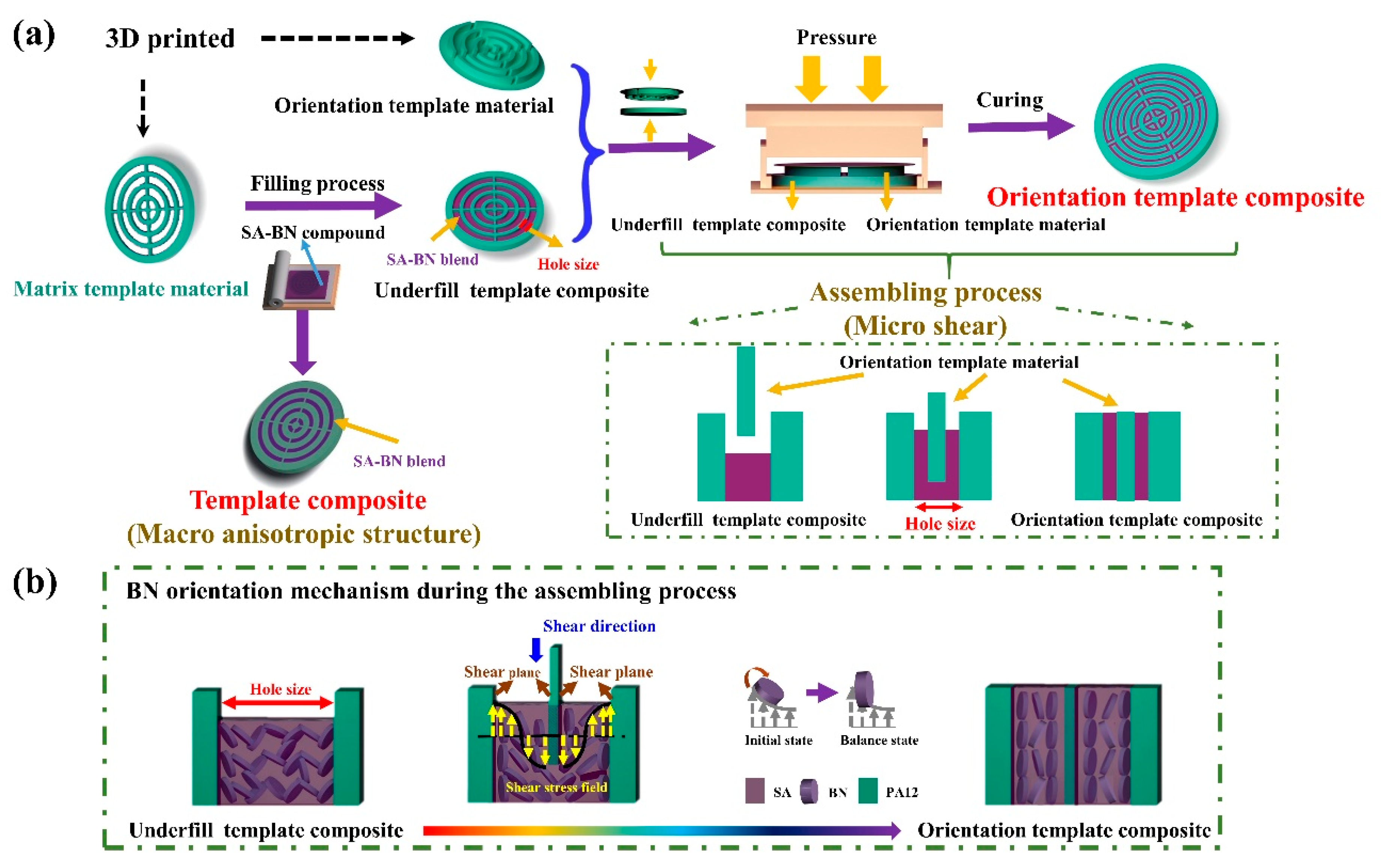
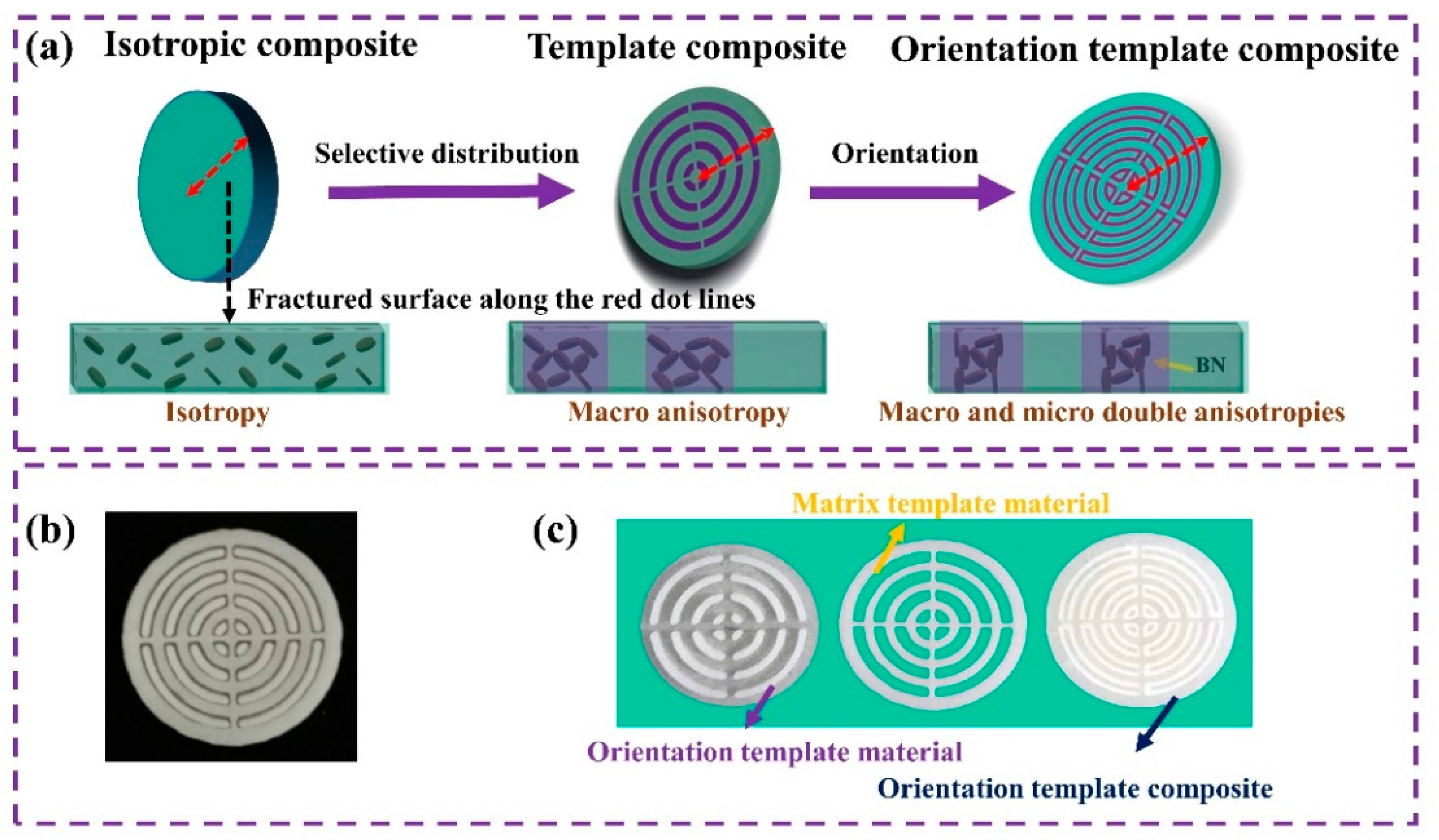

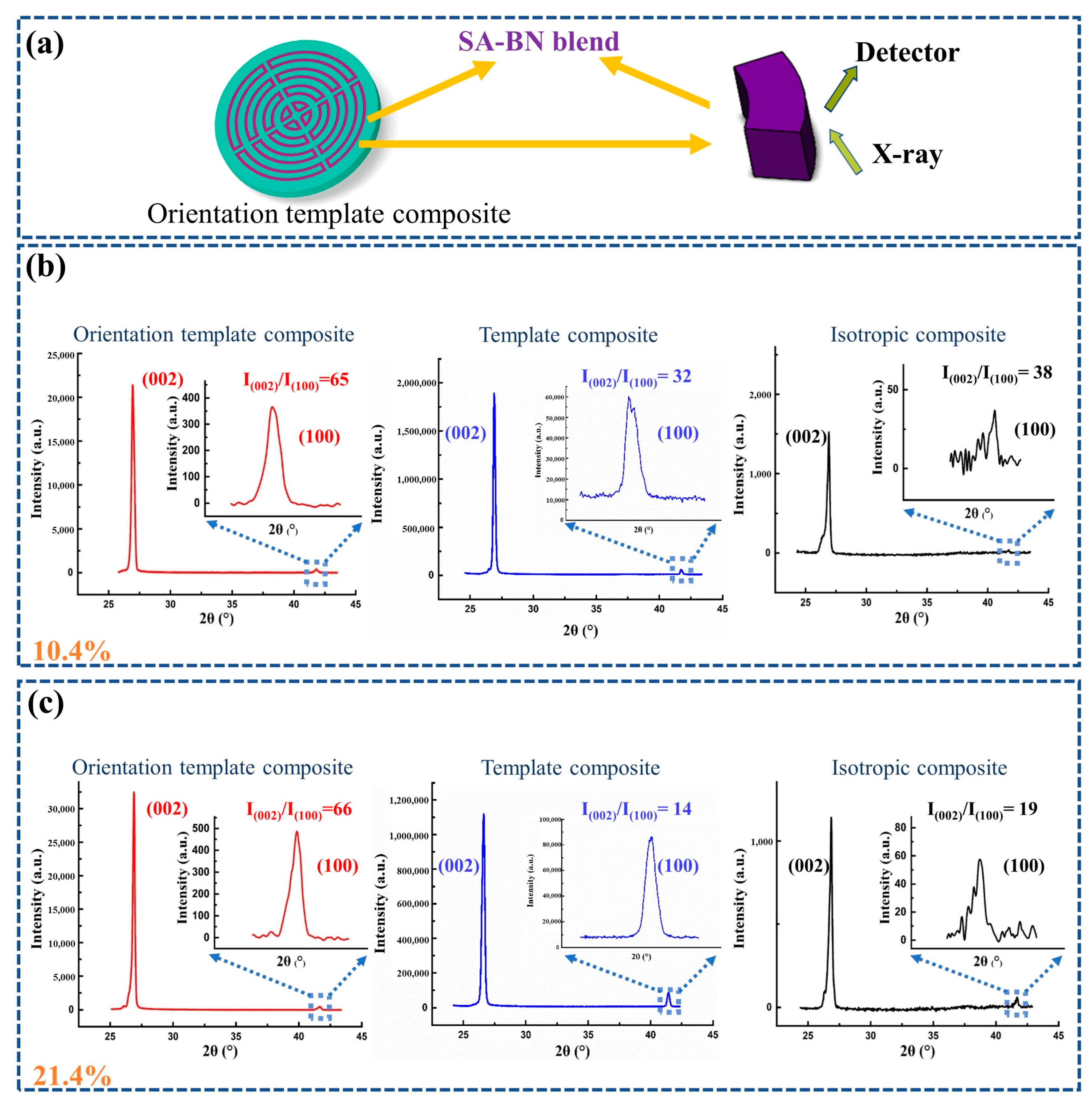
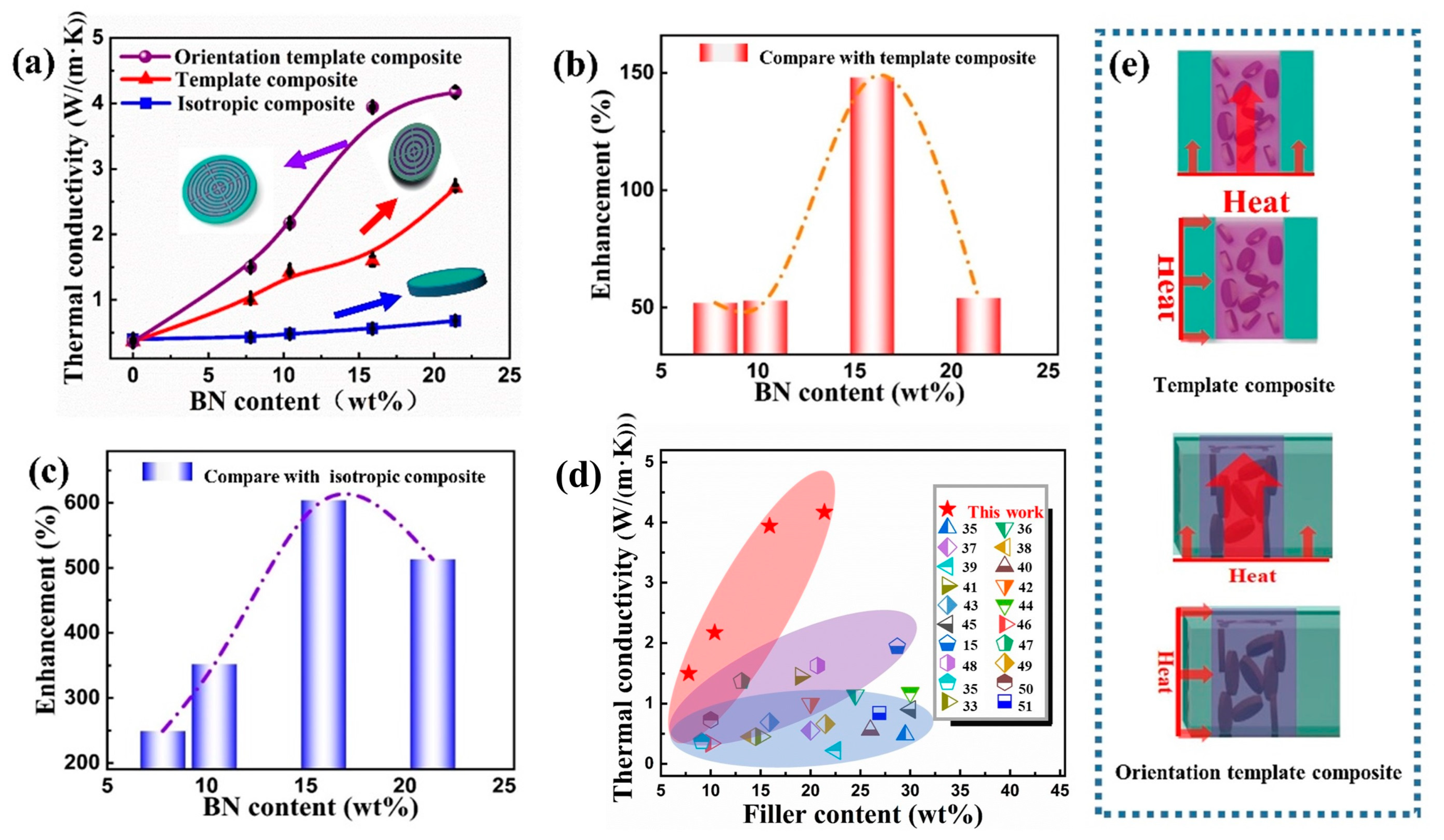
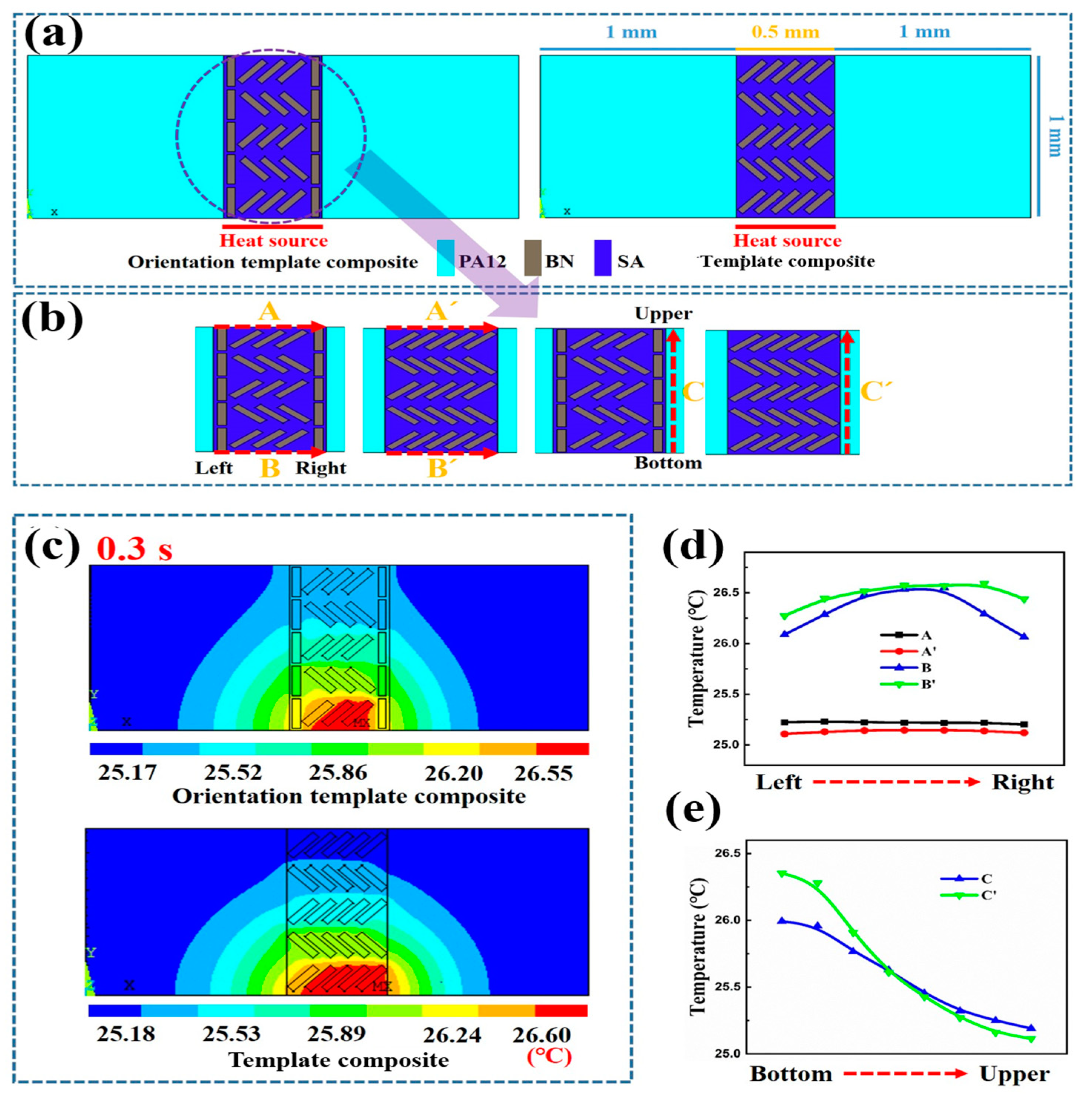
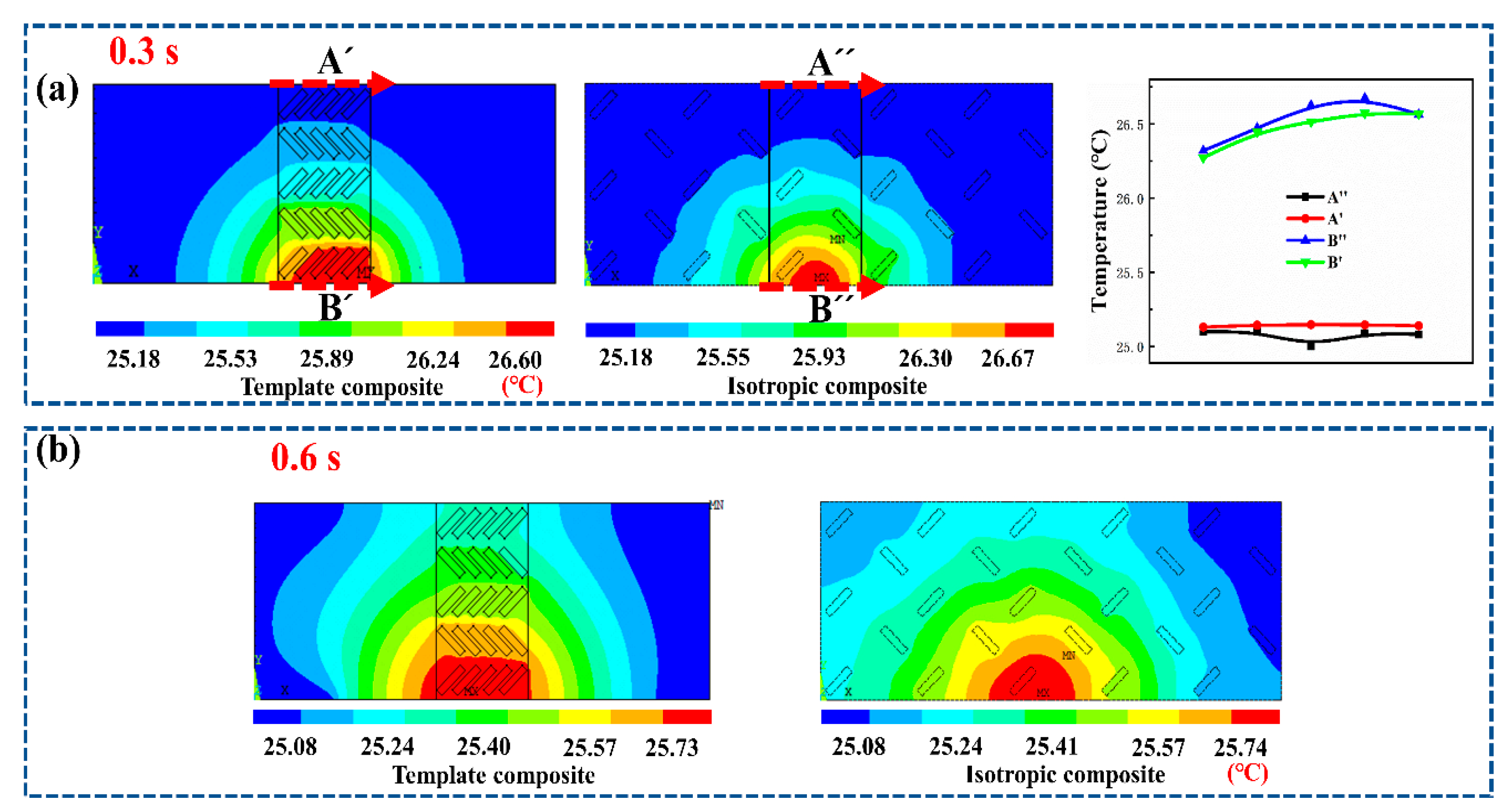
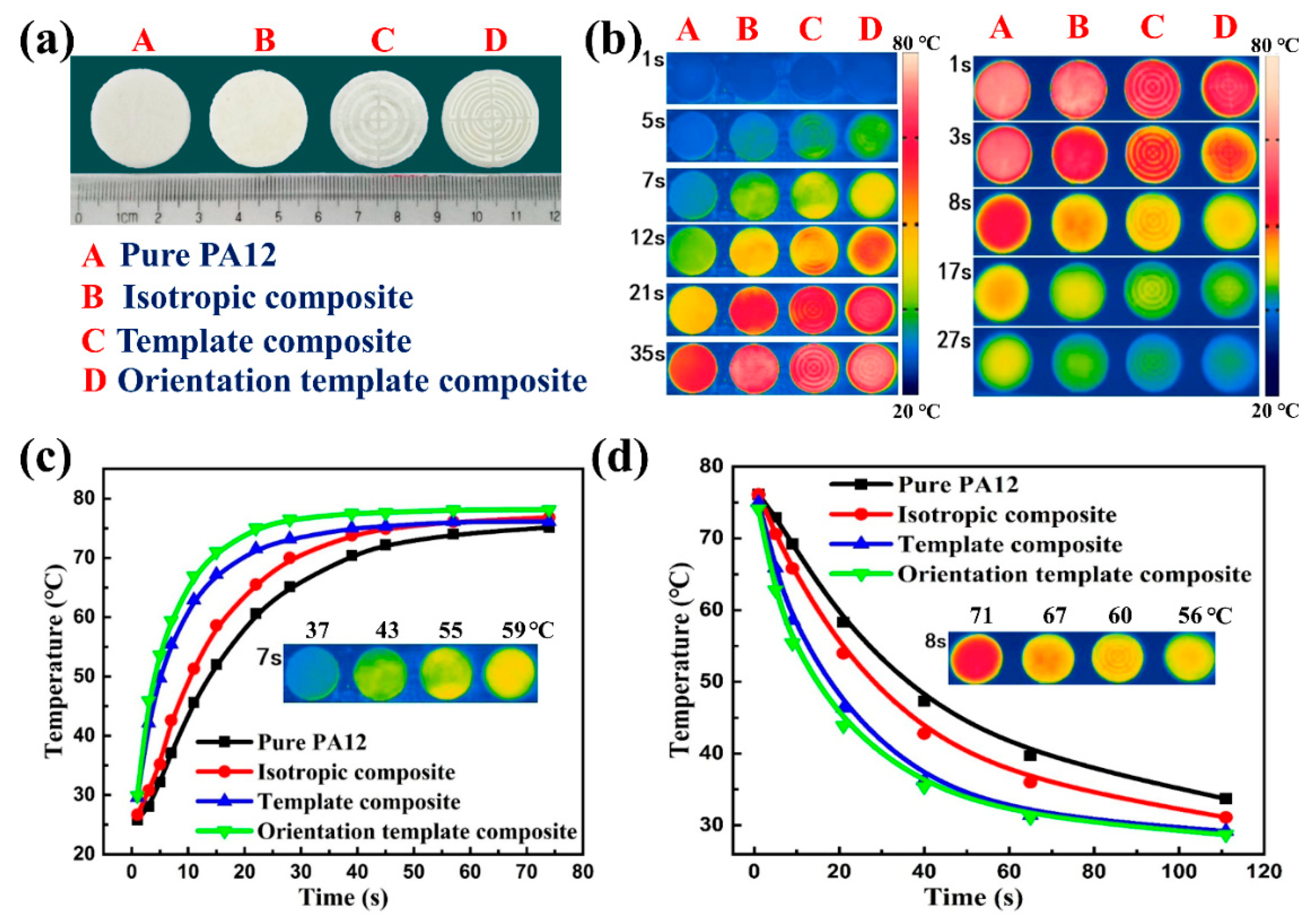
Disclaimer/Publisher’s Note: The statements, opinions and data contained in all publications are solely those of the individual author(s) and contributor(s) and not of MDPI and/or the editor(s). MDPI and/or the editor(s) disclaim responsibility for any injury to people or property resulting from any ideas, methods, instructions or products referred to in the content. |
© 2023 by the authors. Licensee MDPI, Basel, Switzerland. This article is an open access article distributed under the terms and conditions of the Creative Commons Attribution (CC BY) license (https://creativecommons.org/licenses/by/4.0/).
Share and Cite
Chen, M.; Chen, X.; Zhang, J.; Xue, B.; Zhai, S.; She, H.; Zhang, Y.; Cui, Z.; Fu, P.; Pang, X.; et al. 3D-Printed Polyamide 12/Styrene–Acrylic Copolymer–Boron Nitride (PA12/SA–BN) Composite with Macro and Micro Double Anisotropic Thermally Conductive Structures. Polymers 2023, 15, 2780. https://doi.org/10.3390/polym15132780
Chen M, Chen X, Zhang J, Xue B, Zhai S, She H, Zhang Y, Cui Z, Fu P, Pang X, et al. 3D-Printed Polyamide 12/Styrene–Acrylic Copolymer–Boron Nitride (PA12/SA–BN) Composite with Macro and Micro Double Anisotropic Thermally Conductive Structures. Polymers. 2023; 15(13):2780. https://doi.org/10.3390/polym15132780
Chicago/Turabian StyleChen, Minhang, Xiaojie Chen, Junle Zhang, Bingfeng Xue, Shangyu Zhai, Haibo She, Yuancheng Zhang, Zhe Cui, Peng Fu, Xinchang Pang, and et al. 2023. "3D-Printed Polyamide 12/Styrene–Acrylic Copolymer–Boron Nitride (PA12/SA–BN) Composite with Macro and Micro Double Anisotropic Thermally Conductive Structures" Polymers 15, no. 13: 2780. https://doi.org/10.3390/polym15132780
APA StyleChen, M., Chen, X., Zhang, J., Xue, B., Zhai, S., She, H., Zhang, Y., Cui, Z., Fu, P., Pang, X., Liu, M., & Zhang, X. (2023). 3D-Printed Polyamide 12/Styrene–Acrylic Copolymer–Boron Nitride (PA12/SA–BN) Composite with Macro and Micro Double Anisotropic Thermally Conductive Structures. Polymers, 15(13), 2780. https://doi.org/10.3390/polym15132780








